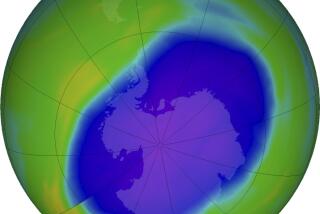Ozone is found to curb plants’ powers
- Share via
Rising levels of ozone pollution near the ground are damaging the ability of plants to take up carbon dioxide, reducing their potential to act as a counterbalance to greenhouse gas accumulation, scientists said Wednesday.
When affected by projected high levels of ozone, plants can absorb up to one-third less carbon dioxide than healthy plants, the researchers found.
The finding adds a new component that will have to be factored into climate models used to assess the future effects of global warming, they said.
The study, published online by the journal Nature, was the first to consider the indirect effect of ozone on vegetation.
“It points out a real gap in our knowledge of climate change,” said David Karnosky, a global change scientist at Michigan Technological University who was not associated with the study.
Ozone forms when nitrogen oxides and volatile hydrocarbons meet in the presence of sunlight. The precursors to ozone come primarily from the burning of fossil fuels, although plants also emit carbon compounds that can participate in the reaction.
High in the stratosphere, ozone is beneficial, shielding Earth from harmful radiation. In the lower atmosphere, it functions as a greenhouse gas and is an air pollutant that can make it hard for people to breathe.
Ozone pollution is particularly high downwind of industrial areas across the eastern United States, Southern California and parts of Texas.
The gas attacks plants by breaking down their cells, reducing growth and causing premature aging.
While the U.S. has been trying to limit nitrogen oxide emissions, ozone levels are creeping upward because of continued burning of fossil fuels.
In some areas of the world, ozone levels are above 40 parts per billion. Some computer models project that 40 parts per billion will be the global norm by 2100 and that levels will exceed 70 parts per billion in some areas, according to the study.
The researchers, led by Stephen Sitch, a climate scientist at the Met Office Hadley Center for Climate Change in Britain, used computer models to analyze how plant life would respond to increasing levels of carbon dioxide and ozone.
Sitch and his colleagues projected that the largest reduction in carbon absorption would take place over North America, Europe, China and India.
“In those areas where ozone is a very large driver, the capability of those trees planted to sequester carbon is going to be limited,” Karnosky said.
The scientists have not calculated how the ozone factor will affect temperature predictions.
--





